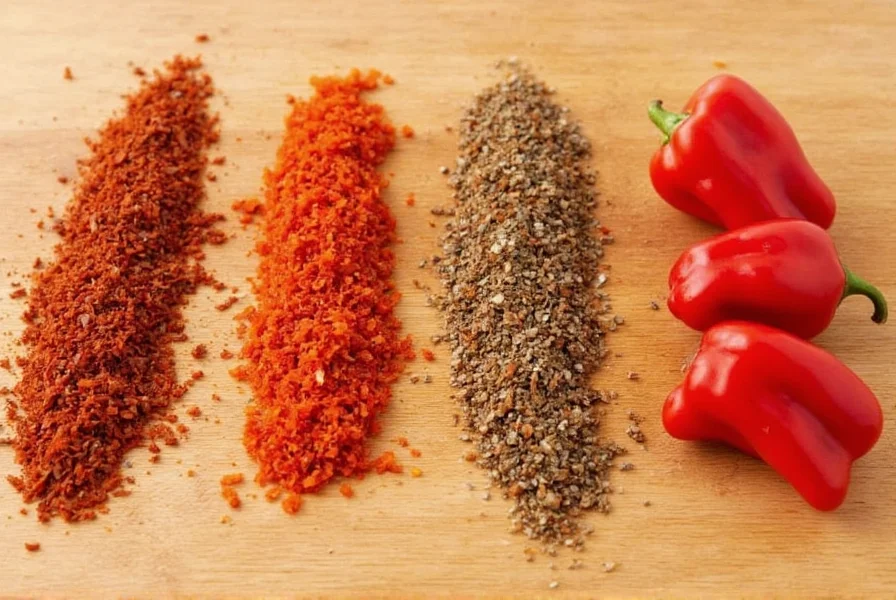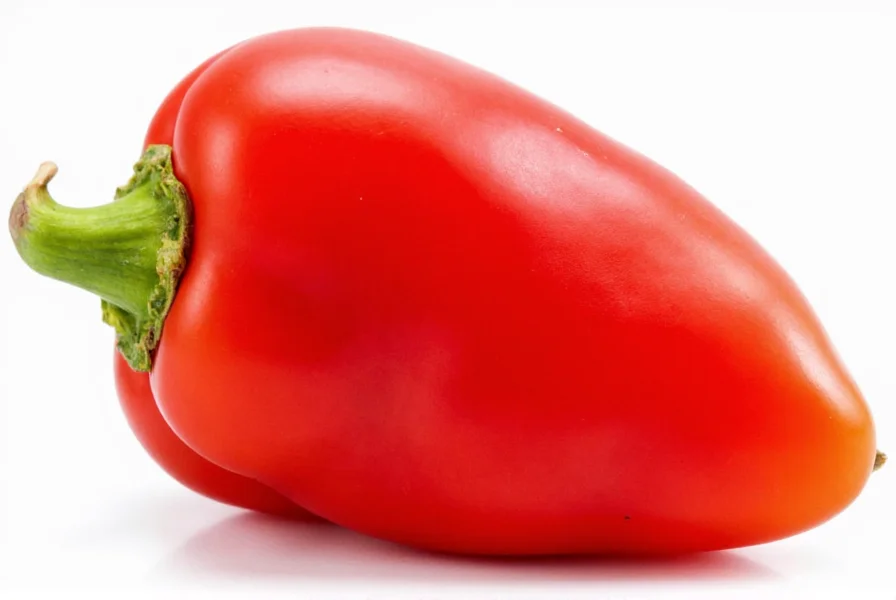Calabrian peppers, native to Italy's Calabria region, are prized for their distinctive balance of fruity sweetness and moderate heat. When unavailable, finding an accurate substitute requires understanding their unique flavor profile: bright, slightly smoky, with a slow-building warmth that enhances rather than overwhelms dishes. This guide provides tested alternatives that maintain your recipe's integrity whether you're making 'nduja, pasta sauces, or roasted vegetables.
What Makes Calabrian Peppers Unique
Growing in Calabria's Mediterranean climate produces peppers with complex flavor notes unlike standard chili varieties. These small, pointed peppers (Capsicum annuum) typically measure 25,000-30,000 Scoville heat units—hotter than jalapeños but milder than habaneros. Their distinctive characteristics include:
- Fruity undertones with berry-like sweetness
- Subtle smokiness from traditional sun-drying
- Medium heat that builds gradually
- Thick flesh ideal for oil preservation
Most commercially available Calabrian peppers come preserved in oil with garlic and herbs, adding another layer of complexity that simple dried chili flakes can't replicate alone. Understanding these elements helps select the most appropriate Calabrian pepper alternatives for cooking without compromising your dish.

Top 5 Calabrian Pepper Substitutes Ranked
Not all chili alternatives work equally well as Calabrian chili pepper substitute options. These substitutes are ranked by flavor compatibility, heat level match, and culinary versatility:
| Substitute | Flavor Match | Heat Level | Best For | Substitution Ratio |
|---|---|---|---|---|
| Crushed red pepper + olive oil | ★★★☆☆ | Adjustable | Sauces, marinades | 1:1 with 1 tsp oil per tbsp flakes |
| Aleppo pepper | ★★★★☆ | Milder (10k SHU) | Dry rubs, finishing | 1.25:1 (use 25% more) |
| Cherry pepper flakes | ★★★★☆ | Similar (25k SHU) | Pasta, pizza | 1:1 |
| Guindilla peppers | ★★★☆☆ | Milder (5k SHU) | Tapas, stews | 1.5:1 (use 50% more) |
| Chipotle powder | ★★☆☆☆ | Hotter (5k-10k SHU) | BBQ, hearty dishes | 0.5:1 (use half amount) |
Detailed Substitute Analysis
Crushed Red Pepper Flakes with Olive Oil (Best All-Purpose Substitute)
This combination most effectively mimics preserved Calabrian peppers. Standard red pepper flakes lack the fruity notes and oil preservation, but adding extra-virgin olive oil creates a similar texture and mouthfeel. For optimal results when seeking how to replace Calabrian peppers in recipes:
- Mix 1 tablespoon red pepper flakes with 1 teaspoon good quality olive oil
- Add a pinch of sea salt to enhance flavor complexity
- Let sit 10 minutes before using to allow flavors to meld
- Add 1/4 teaspoon smoked paprika for dishes requiring deeper smokiness
This substitute works particularly well in tomato-based sauces, on pizza, or as a finishing oil for grilled meats. The oil carries the heat evenly while softening the flakes' sharp edges.
Aleppo Pepper (Best for Dry Applications)
Hailing from Syria and Turkey, Aleppo pepper offers a comparable fruitiness with moderate heat (10,000 Scoville units). Its slightly lower heat level makes it ideal when you want the flavor without overwhelming spice. When using Aleppo as your Calabrian pepper substitute:
- Increase quantity by 25% to match Calabrian heat level
- Add 1/2 teaspoon lemon zest per tablespoon to boost fruitiness
- Best for dry rubs, salad dressings, and finishing dishes
- Reconstitute with water (1:1 ratio) for sauce applications
Chef Marco Bianchi of Rome's La Cucina notes: "Aleppo pepper's citrus notes make it surprisingly close to Calabrian when used thoughtfully. The key is balancing its milder heat with complementary flavors."
Specialized Substitution Guidelines
Different cooking applications require tailored approaches when seeking Calabrian pepper alternatives for cooking. These specific recommendations ensure optimal results:
For 'Nduja and Spreadable Pastes
When replicating this Calabrian specialty spread, combine:
- 1 tablespoon red pepper flakes
- 2 tablespoons olive oil
- 1 small roasted red bell pepper
- 1 minced garlic clove
- 1/4 teaspoon fennel seeds
Process until smooth. The roasted bell pepper adds necessary sweetness while fennel seeds provide authentic Italian flavor notes missing in basic substitutes.
For Pasta Alla Vodka and Cream Sauces
Cream-based sauces require careful heat balancing. Use this ratio:
- For every 1/2 cup sauce: 1/4 teaspoon cherry pepper flakes + 1/8 teaspoon cayenne
- Add flakes early in cooking to mellow the heat
- Finish with grated pecorino to balance any harshness
Where to Find Authentic Calabrian Peppers
Before reaching for substitutes, check these sources for genuine Calabrian peppers:
- Italian specialty markets (look for "Peperoncini di Calabria" in oil)
- Online retailers (Bianco DiNero, Gustiamo, Eataly)
- High-end grocery stores (Eataly, Whole Foods, Dean & DeLuca)
- Certified imported varieties should list "Calabria" on the label
When purchasing, check for peppers preserved in extra-virgin olive oil with minimal additives—authentic versions contain only peppers, oil, salt, and sometimes garlic. Avoid products with vinegar or preservatives, which alter the delicate flavor profile.
Frequently Asked Questions
Can I use cayenne pepper as a Calabrian pepper substitute?
Cayenne makes a poor direct substitute as it's significantly hotter (30,000-50,000 Scoville units) with a one-dimensional heat lacking Calabrian's fruitiness. If necessary, use only 1/3 the amount of cayenne and add 1/2 teaspoon honey per teaspoon to balance the heat with sweetness.
What's the difference between Calabrian peppers and regular red pepper flakes?
Calabrian peppers come from a specific Italian cultivar with complex fruity notes and moderate heat (25,000-30,000 Scoville). Standard red pepper flakes are typically made from multiple chili varieties with sharper, less nuanced heat. Authentic Calabrian peppers are usually preserved in oil, while most red pepper flakes are dried.
How much crushed red pepper equals one Calabrian pepper?
One medium Calabrian pepper equals approximately 1 1/4 teaspoons crushed red pepper flakes. For preserved peppers in oil, use 1 tablespoon of peppers (including oil) per pepper called for in recipes. Remember that heat levels vary between brands, so always taste as you go.
Can I substitute paprika for Calabrian peppers?
Standard sweet paprika lacks sufficient heat, but smoked paprika can work when combined with heat sources. For each teaspoon of Calabrian peppers, use 3/4 teaspoon smoked paprika plus 1/4 teaspoon red pepper flakes. This combination replicates both the smokiness and moderate heat profile.
Do Calabrian pepper substitutes work in baking?
Yes, but with adjustments. For chocolate or spice cakes calling for Calabrian peppers, use 1/2 teaspoon ancho chili powder plus a pinch of cayenne per pepper. The ancho provides fruitiness while cayenne adds subtle heat. Reduce sugar by 1 teaspoon per substitution to balance the increased sweetness perception from the chili.











 浙公网安备
33010002000092号
浙公网安备
33010002000092号 浙B2-20120091-4
浙B2-20120091-4